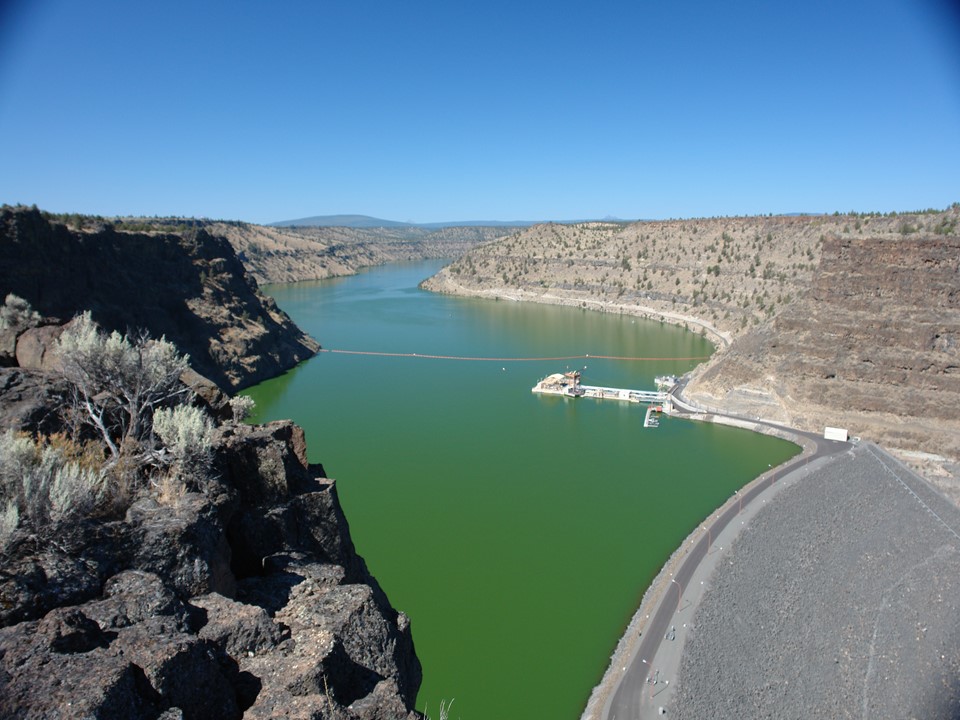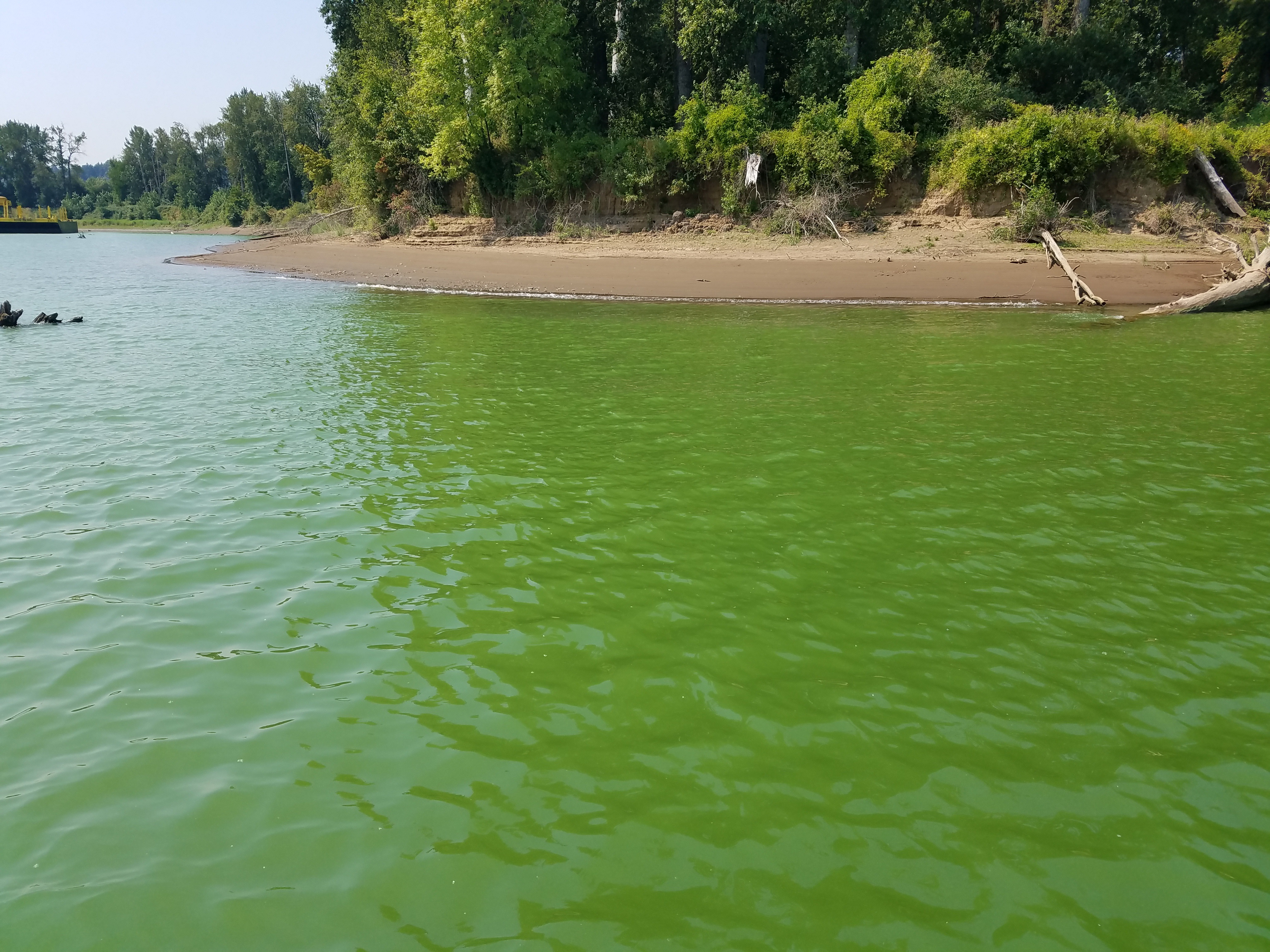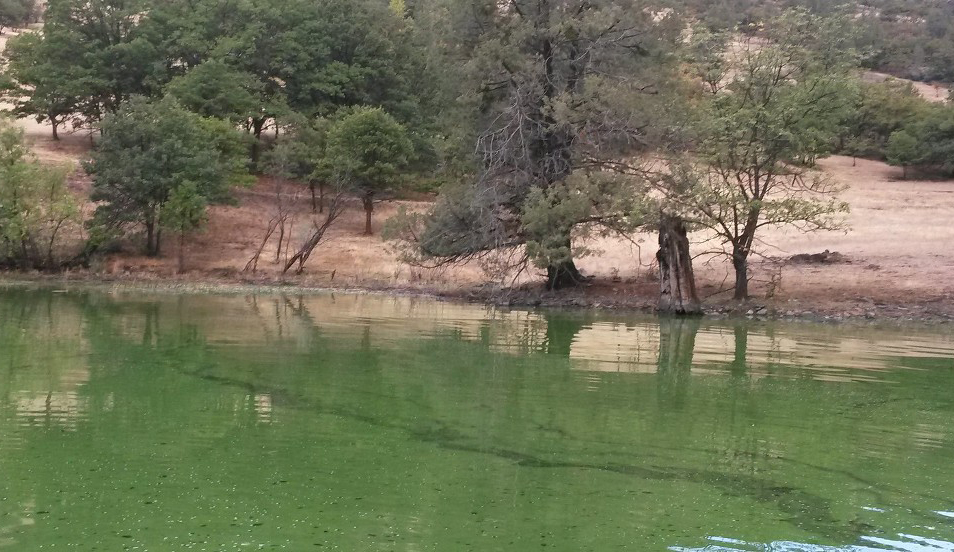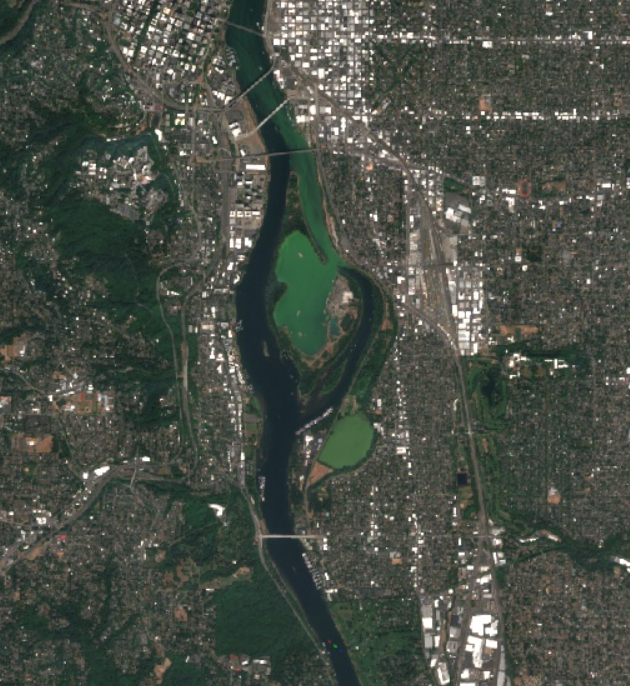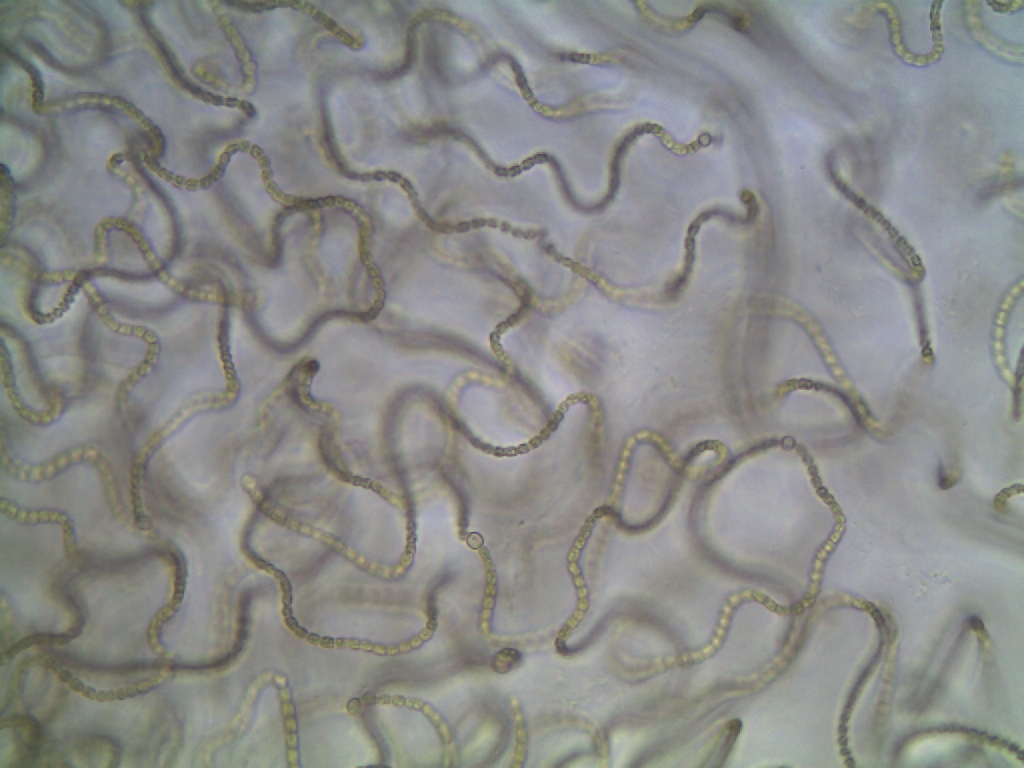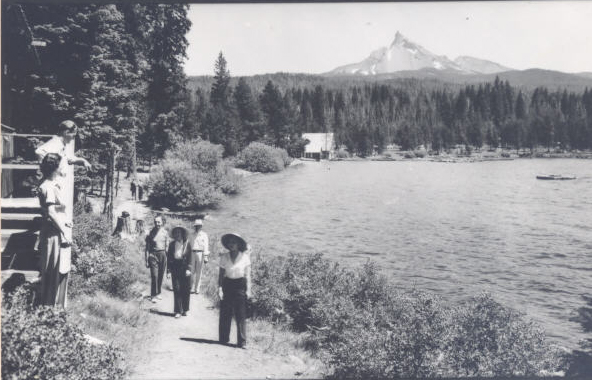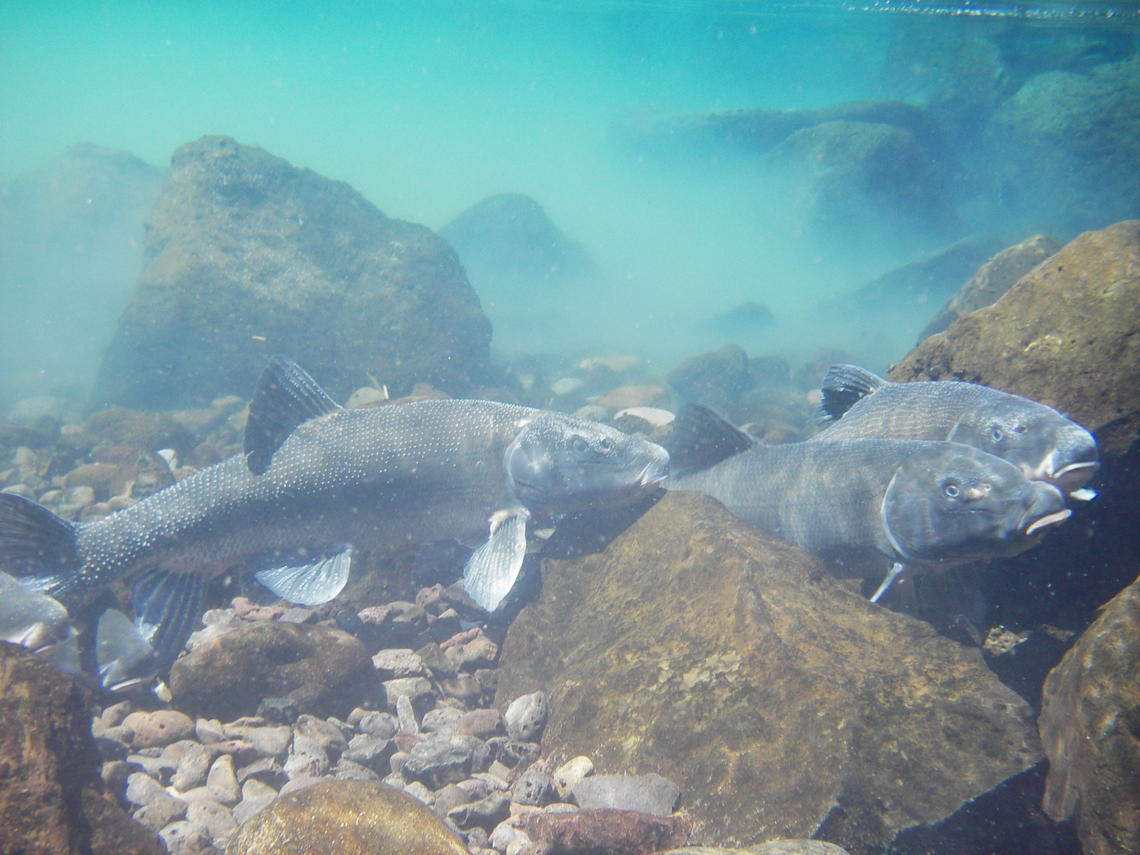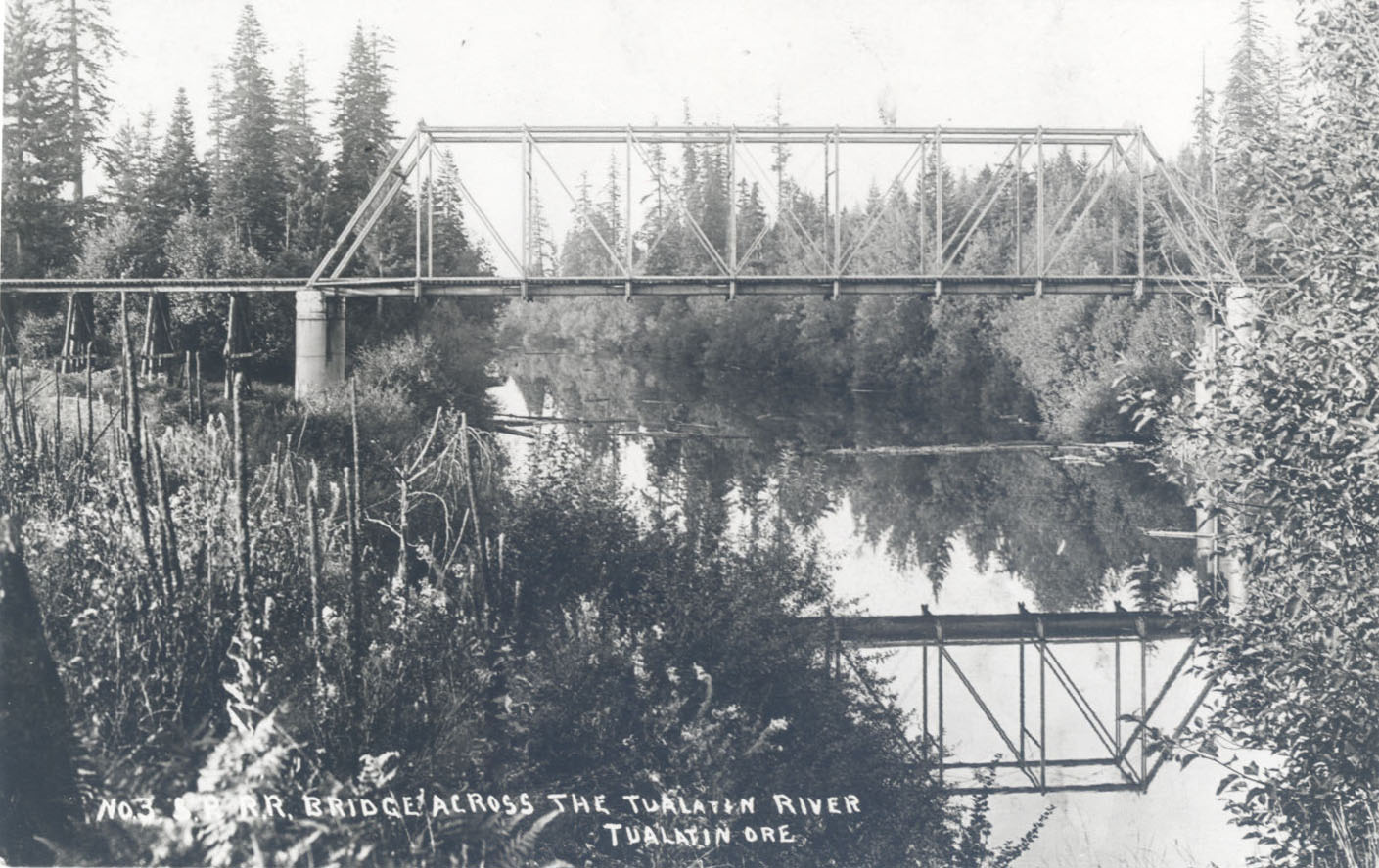The term “algae” is a generic description of a diverse group of single and multicellular aquatic plant organisms that produce energy and oxygen through photosynthesis. Algae are a natural and vital part of healthy ecosystems and form the base of most aquatic food webs. The thousands of species of algae include diatoms and algae identified by color, such as green, red, and brown. So-called blue-green algae, or cyanobacteria, is a microscopic organism that shares the same qualities as algae but is classified as a bacteria, generally beneficial to its environment. Under certain conditions, however, floating or “planktonic” algae and cyanobacteria reproduce quickly and develop into a bloom—a large, overgrown biomass that fouls a body of water. Although many types of algae can cause these harmful algal blooms (HABs), including the threadlike green algae that sometimes grow excessively in Oregon rivers, cyanobacteria are usually the culprit.
HABs can occur in all types of aquatic environments, including lakes, reservoirs, rivers, streams, and even wetlands. The rapid rise in the abundance of cyanobacteria to the point where it forms a surface scum causing significant changes to the quality of the water or produces cyanotoxins is considered a HAB (or a CyanoHAB or HCB, a harmful cyanobacterial bloom). HABs often occur in boom-and-bust cycles that can have severe negative effects on water quality. The decay of HABs consumes dissolved oxygen, which may be stressful or lethal for fish, and facilitates the bioaccumulation of toxic substances such as mercury. The decay may also release toxins produced by blue-green algae, which are of particular concern for the health of aquatic life, humans, and other animals.
The Abundance of Blue-Green Algae in Oregon
Over billions of years, blue-green algae have evolved strategies to outgrow their competitors. Those strategies include using particular photosynthetic pigments–phycocyanin and phycoerythrin–to capture wavelengths of light and nutrients that are unavailable to other algae. Blue-green algae are capable of controlling their position in the water column, creating buoyancy by using gas vesicles–that is, cylindrical tubes able to absorb gases. Cyanobacteria can utilize atmospheric nitrogen (N2) dissolved in water as a source for cellular growth. They also have nutrient storage mechanisms that allow them to grow and multiply quickly into a bloom when conditions are favorable, such as warm water and high levels of nitrogen and phosphorus. Some species of cyanobacteria have spores (called akinetes) that overwinter in lake sediments and germinate in spring. Once a body of water is affected, it is more prone to re-bloom when the spores that accumulated during earlier blooms germinate.
HABs occur in Oregon because of several important factors, including the prevalence of phosphorus-rich volcanic rocks and clear waters that allow light to penetrate deeply. The abundance of natural phosphorus, relative to a low level of biologically available nitrogen, results in many waters being “nitrogen limited.” This condition gives a competitive advantage to organisms such as blue-green algae that are capable of pulling the unlimited supply of inert nitrogen from the atmosphere.
Many of Oregon’s lakes, reservoirs, and rivers with HABs have relatively low nitrogen concentrations, including most Cascade Range reservoirs, such as Detroit Lake. That gives an advantage to nitrogen-fixing cyanobacteria, particularly Dolichospermum (a genus formerly named Anabaena), Gloeotrichia, Aphanizomenon, and a benthic (bottom-dwelling) species of Nostoc. Abundant natural phosphorus also means that waters and the organisms living in them are less likely to respond to excess phosphorus created by human activities, such as shifting soil and sediment or the introduction of waste, making some Oregon bodies of water particularly sensitive to the effects of nitrogen enrichment.
From 2007 to 2023, the Oregon Health Authority issued over 200 HAB advisories in more than 60 waterbodies in Oregon. The 11 advisories issued between January and October 2023 included the Willamette River between the Ross Island Lagoon and Cathedral Park; Cascade Range reservoirs, including Detroit and Timothy Lakes; Devils Lake, Ten Mile Lake, Cullaby Lake, and Carnahan Lake on the coast; and waterbodies around Portland that included Laurelhurst Park Pond, River Forest Lake, Clackamette Cove, and Blue Lake. Upper Klamath Lake, the largest lake in Oregon, experiences an annual, massive bloom.
Willow Creek Reservoir near Heppner also experienced recurring blooms of Microcystis and AFA, resulting in recreational advisories by the Oregon Health Authority in 2017–2019. Another potential cyanotoxin-producing cyanobacterium, Gloeotrichia, has occurred frequently in Lake Oswego and in Blue River Lake in the McKenzie River basin. A harmful algal bloom on Brownlee Reservoir and Hells Canyon dam, on the Snake River along Oregon’s eastern state line, led to advisories in 2019. Small farm, nursery, and stock ponds are also susceptible to HABs.
HABs may also be supported by phosphorus-rich basalts, including off-channel ponds along the South Umpqua River, the kolk lakes of the Columbia River Gorge, and along many miles of the upper Clackamas and North Santiam Rivers and other rivers in the Cascade Range where basalt cliffs were turned into roadbeds.
On the coast, Oregon shellfish, including razor clams, mussels, and Dungeness crabs, have also been periodically affected by biotoxins, including domoic acid (a neurotoxin) produced by the marine diatom Pseudonitzschia. The Oregon Department of Fish and Wildlife monitors biotoxins and periodically issues restrictions on their collection.
Health Concerns
Cyanotoxins produced by HABs have the potential to cause significant harm to pets, livestock, wildlife, and humans. Federal and state agencies, utilities, and watershed groups have issued a warning for people and their pets and livestock to avoid waters where HABs have formed: “When in Doubt, Stay Out!” The Oregon Health Authority, for example, issued a permanent advisory for Lawson Bar and the South Umpqua River near Canyonville after repeated incidents of dogs having seizures and dying, possibly from neurotoxin (anatoxin) exposure. In 2017, Dolichospermum was suspected in the deaths of 32 cattle after they drank water from Junipers Reservoir in southeastern Oregon. The distinct blue color pigment on the animals’ legs was a clear sign that cyanobacteria were responsible.
In 2018, a bloom of Dolichospermum in Detroit Lake resulted in the detection of microcystins and cylindrospermopsin (cyanotoxins) in the lake and in the City of Salem’s drinking water. Officials issued an unprecedented drinking-water advisory that lasted about a month. Cyanobacteria often produce compounds that cause odd tastes and odors and contribute to the formation of carcinogenic disinfection byproducts in treated drinking water. Harmful algae blooms have a cost to human activity, impairing recreation, causing economic hardships from lost revenue, adding to water treatment costs, and lowering real estate values. They can also exert an increased burden on marginalized and underrepresented communities because of the lack of effective communication they receive about the risks of HABs.
Responses to HABs
The Oregon Health Authority’s Drinking Water Program, with guidance from the U.S. Environmental Protection Agency, has helped public water systems manage the risks posed by HABs. In 2020, after the HAB at Detroit Lake affected Salem’s drinking water, the Oregon legislature increased support for DEQ’s laboratory and field activities related to HABs. Local drinking-water providers and water managers have been working with scientists to find ways to anticipate blooms, enhance rapid response strategies, and implement advanced water treatment. Since 2019, researchers at DEQ, the U.S. Forest Service, Portland State University, Oregon State University, and the USGS collaborated on comparing satellite-derived estimates of cyanobacteria with real-time field measurements in a series of lakes and reservoirs in the upper Deschutes River basin, including Odell Lake and Crane Prairie Reservoir.
In 2023, the USGS deployed a continuous, water-quality monitor in the Willamette River at the Oregon Museum of Science and Industry dock to monitor HABs exiting the Ross Island Lagoon to provide early warnings about a bloom exiting the lagoon. Statewide, the DEQ has used satellite estimates from the Cyanobacteria Assessment Network Project to identify blooms, and Oregon DEQ issues weekly updates based on that data for forty-nine large waterbodies.
-
![]()
Cynobacterium Gloeotrichia echinulata.
Courtesy USGS -
![]()
HAB in Lake Billy Chinook, Oregon, 2019.
Courtesy Deschutes River Alliance -
![]()
Algae Bloom at the Ross Island Lagoon in the Willamette River, 2018.
Courtesy USGS, Kurt Carpenter -
![]()
HAB on Klamath River Reservoir.
Courtesy Oregon State University -
![Ross Island area, Portland]()
Satellite image showing green algae in the Willamette River, 2023.
Ross Island area, Portland Courtesy USGS -
![]()
Blue-green algae (Cyanobacteria-Nostoc).
Courtesy USGS
Related Entries
-
![Climate Change in Oregon]()
Climate Change in Oregon
Within a few hundred miles in Oregon, you can see snowy volcanoes, parc…
-
![Department of Environmental Quality]()
Department of Environmental Quality
The Oregon Department of Environmental Quality (DEQ) administers and en…
-
![Diamond Lake]()
Diamond Lake
“Gem of the Cascades” is how Diamond Lake is heralded by those who trou…
-
![Endangered Klamath suckers]()
Endangered Klamath suckers
Since Lost River suckers (Deltistes luxatus) and shortnose suckers (Cha…
-
![The Blob: Impacts of the 2013-2016 Marine Heatwave on Oregon]()
The Blob: Impacts of the 2013-2016 Marine Heatwave on Oregon
From December 2013 to August 2016, the northeast Pacific Ocean experien…
-
![Tualatin Riverkeepers]()
Tualatin Riverkeepers
Tualatin Riverkeepers, a community-based organization that works to pro…
Related Historical Records
Map This on the Oregon History WayFinder
The Oregon History Wayfinder is an interactive map that identifies significant places, people, and events in Oregon history.




